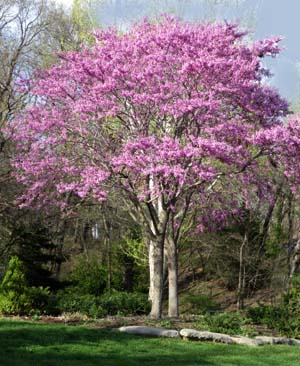
Redbud trees bloom in Kansas early in April in the wild and in towns. This photo was taken in a suburb of Wichita.
Even bloggers have to go on vacation sometime. Last week my husband and I traveled to Kansas to visit family and to enjoy southeastern Kansas in its springtime glory. The tulip displays at Wichita’s Bontanica are phenomenal, and redbud trees – a favorite of mine – bloom in the wild and in towns early in April.
In the midst of roaming country roads to view redbud trees growing wild, we dropped by Elk Falls. This quiet town of about 100 residents, almost 70 miles southeast of Wichita, has been the home of Elk Falls Pottery for 39 years. Founders Steve and Jane Fry turn out thousands of mugs and other pottery items every year from high-quality clay Steve digs out of Kansas earth.
I had seen pictures of their work on Facebook and wondered how they produce mugs with all types of logos and letters. Steve and Jane showed me not only how they make them but also how Steve makes the clay from which they are thrown.
Tricks of the Trade and an Artist’s Eye
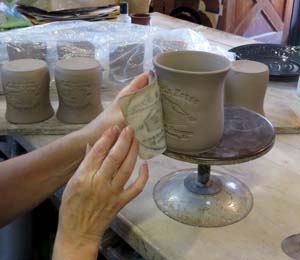
Jane Fry pulls away the flexible polymer die that has imprinted a design on a mug for the Little House on the Prairie Museum.
When Steve and Jane started Elk Falls Pottery in 1976, Steve carved designs by hand on every mug. A couple of years later he learned of a company in Wichita that could make a pliable polymer die from a drawing he provided. Designs from Elk Falls Pottery could be more complex because he would no longer have to hand carve each one.
Today even providing designs for the die is much easier. Steve sends the company a digital image that he has created or that he has adjusted from what a customer sent him.
While I was there, Jane was working on adding the design for the Little House on the Prairie Museum to the museum’s most recent order of mugs. I noticed that in spite of the convenience of the polymer die, it still takes great care to align it perfectly on a partially dried mug and to make sure every part of the die is pressed into the clay.
After the mugs go through their first firing in the kiln, Steve applies colored glaze to the design generously. Excess glaze around the lettering will be wiped off when the glaze is dry. After brushing liquid wax over the logo to protect its glaze, he dips the mug into the glaze that will color the remainder of the mug. In the kiln the wax burns off and all of the glazes he has applied become as hard as glass.
While he applied custom-colored glaze to a mug for Hesston College, Steve told me he had taken a sculpture class there long ago. The instructor had introduced him to working with clay, and Steve was quickly hooked on the medium. The class had gone to privately owned land where they had permission to dig up their own clay.
Decades later, Steve still goes there to obtain clay for Elk Falls Pottery. The connection he feels to the earth and to what he produces from it gives him a satisfaction that make the hard work worth the effort.
Getting Down to Earth
Four hours away from Elk Falls lies a field where the landowner allows Steve to dig up clay ideal for high-temperature firing. In the large bin where he stores the raw clay, it looks like pale gray, powdery dirt. The process that turns it into potter’s clay takes about three weeks. To keep a continuous supply available, Steve always keeps some in the works.
The process begins by mixing 150 pounds of clay with 45 gallons of water in a tall cylinder reminiscent of a home water heater. Steve runs the mixture through a sieve that has a screen twice as fine as a window screen. The part that makes it through the screen is high-quality clay.
The clay eventually separates from much of the water. Steve removes the excess water before adding clay that he has purchased. To achieve all the characteristics he wants, he combines the clay he has dug with purchased clay in approximately a 3:1 ratio. Finally comes the long process of drying the clay to the consistency where it can be thrown on a wheel or pressed into a slab.
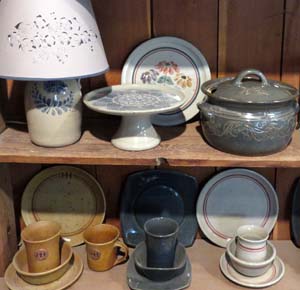
Steve and Jane Fry sell their pottery right from their studio space by their home in Elk Falls, Kansas.
Steve and Jane create pottery by both methods. They never find themselves without orders to fill, either. Their biggest seller is their mugs, not only for colleges and businesses but also for reunions and other special events.
They have been making mugs for the Walnut Valley Festival – the annual bluegrass festival in Winfield, Kansas – for over 30 years. Steve makes a new design for the festival’s mug each year, and he and Jane turn out 900 of them. People line up to buy the mugs before they finish setting up their booth, Steve told me; the rush for mugs lasts about three hours.
Steve and Jane have been making pottery for so long that they’re starting to see second generation users of Elk Falls pottery. People who grew up with it are ordering it for their own homes. After 39 years in business, Steve and Jane have no plans to retire. “We’re already doing what we want to do,” they told me.
Our springtime trip to Kansas concluded the next day with a visit to Botanica, Wichita’s botanical gardens. The tulips had burst into bloom in more colors, shapes, and sizes than I could have imagined. Nature’s own art with a little help from man.

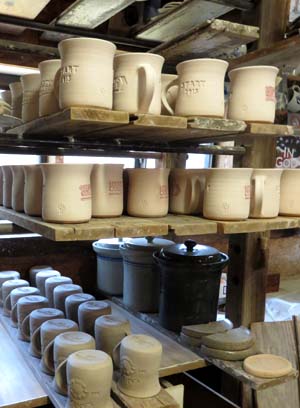
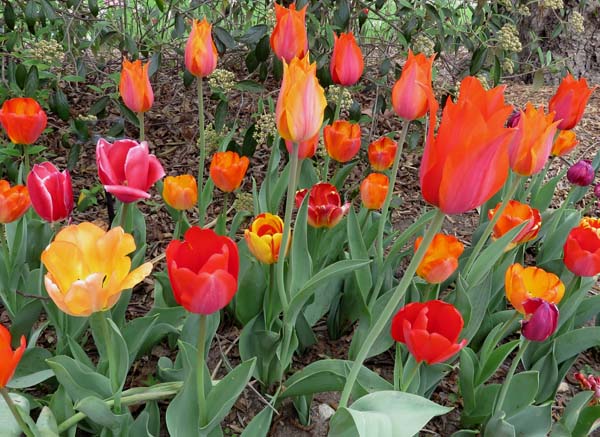
Beautiful tulips and tree. Carol
They were quite a spectacle indeed.